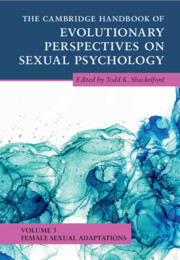Book contents
- The Cambridge Handbook of Evolutionary Perspectives on Sexual Psychology
- The Cambridge Handbook of Evolutionary Perspectives on Sexual Psychology
- Copyright page
- Contents
- Contributors
- Preface
- Part I Precopulatory Adaptations
- 1 Women’s Preferences: Precopulatory Adaptations
- 2 Female Sexual Attraction Tactics
- 3 Extra-Pair Sexual Interest
- 4 Female Intrasexual Competition
- 5 Female Intersexual Selection
- 6 Evolution of Precopulatory Defense from Rape and Coercion in Women
- 7 Mate Poaching
- Part II Copulatory Adaptations
- Part III Postcopulatory Adaptations
- Index
- References
3 - Extra-Pair Sexual Interest
from Part I - Precopulatory Adaptations
Published online by Cambridge University Press: 30 June 2022
- The Cambridge Handbook of Evolutionary Perspectives on Sexual Psychology
- The Cambridge Handbook of Evolutionary Perspectives on Sexual Psychology
- Copyright page
- Contents
- Contributors
- Preface
- Part I Precopulatory Adaptations
- 1 Women’s Preferences: Precopulatory Adaptations
- 2 Female Sexual Attraction Tactics
- 3 Extra-Pair Sexual Interest
- 4 Female Intrasexual Competition
- 5 Female Intersexual Selection
- 6 Evolution of Precopulatory Defense from Rape and Coercion in Women
- 7 Mate Poaching
- Part II Copulatory Adaptations
- Part III Postcopulatory Adaptations
- Index
- References
Summary
Extrapair sex, although not a dominant human mating strategy, has been a part of our mating landscape throughout human history. Although prevalence rates vary across studies, a conservative estimate is that at least 1 out of 5 persons have cheated on a committed partner. In this chapter I discuss theories and evidence addressing extrapair interest and behavior (i.e., cheating on a committed partner) as produced by adaptations. Topics include the costs and benefits of extrapair behavior, comparisons to nonhuman animal extrapair behavior, sex differences, and purported female cyclical variations in extrapair orientation. I briefly discuss proximate factors that predict proclivity to cheat. I also touch on infidelity advertisement, cheating detection, forgiving a partner’s infidelity, and infidelity in popular culture. I conclude with some observations about the state of the field. Regardless of causes and correlates, infidelity can be costly, yet humans remain interested in and intrigued by the phenomenon.
- Type
- Chapter
- Information
- Publisher: Cambridge University PressPrint publication year: 2022



